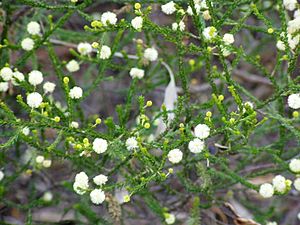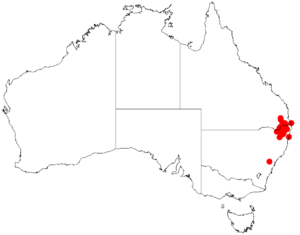Acacia brunioides facts for kids
Quick facts for kids Acacia brunioides |
|
|---|---|
 |
|
| Conservation status | |
|
Rare (NCA)
|
|
| Scientific classification | |
| Genus: |
Acacia
|
| Species: |
brunioides
|
 |
|
| Occurrence data from AVH | |
The Acacia brunioides is a type of plant often called the brown wattle. It's a spreading shrub that grows in Australia. This plant belongs to a big group of plants called Acacia, which are well-known for their beautiful flowers.
Contents
Brown Wattle: An Australian Shrub
Where the Brown Wattle Grows
This plant naturally grows in parts of eastern Australia. You can find it from the Gibraltar Range in New South Wales. Its range extends north to the McPherson Range. It also grows near Toowoomba and between Wallangarra and Stanthorpe in South East Queensland.
What the Brown Wattle Looks Like
The brown wattle is a shrub with many branches. It can grow up to about 2 meters (about 6.5 feet) tall. Its small branches might be smooth or have tiny, soft hairs.
Instead of regular leaves, this plant has special flattened stems called phyllodes. These phyllodes are often arranged in a spiral pattern or in irregular groups. They are quite small, usually between 2.5 and 12 millimeters long. That's about the size of a grain of rice to a small fingernail. They are also very narrow, only 0.4 to 0.7 millimeters wide.
Flowers and Seed Pods
The brown wattle produces simple inflorescences, which means its flowers grow in a simple cluster. Each cluster is a round, ball-shaped flower head. You'll find one of these flower heads where a leaf (or phyllode) meets the stem. Each flower head has about 16 to 27 small flowers. These flowers can be creamy white or a bright golden color.
After the flowers bloom, the plant forms blackish seed pods. These pods are narrow and can be about 5 centimeters (about 2 inches) long. They are usually between 7 and 15 millimeters wide.
Similar Plants
Sometimes, the brown wattle can be mistaken for another plant called Acacia conferta. They look quite similar, which can make them tricky to tell apart!

